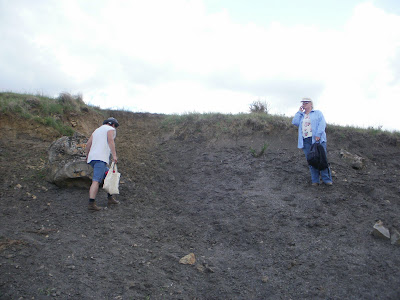It's May 15th, temperatures are in the high 60s, sky is overcast with no immediate threat of rain, winds are 5-15 mph - yep, its time to venture out to the Kill Creek Store shelter for the annual cleanup and overview of Osborne County's Rediscovering Sod-House Days Self-Guided Auto Tour. Set in the west-central part of the county 16 driving miles southwest of the county seat of Osborne, the SHD Tour celebrates the people and places made famous in the classic 1937 book by Kill Creek area homesteader Howard Ruede. The book is still in print and remains popular today, nearly 75 years since its publication.
The shelterhouse, now located on the site of the Kill Creek General Store (1872-1921), is both the starting place and last stop on the SHD loop tour. There are 22 stops along both rock and dirt roads on the three-hour tour, making it a great day trip destination with which to enjoy an outing into the Kansas countryside. The shelter sports both a mailbox holding brochures and a sign-in book for visitors and four markers telling the story of Ruede and his fellow homesteaders in the area during the book's time period of 1877-1878.

The original Kill Creek Store started as a postal stop on the Bull City-Russell Freight Trail. It was operated over the years by a number of people, the longest by Mr. and Mrs. Richard Benwell.

Printer by trade and homesteader by choice, Pennsylvanian-born Howard Herman Ruede (1854-1925) arrived in the Kill Creek community in 1877 and claimed a homestead a mile north of the Kill Creek Store. His letters to his family in Pennsylvania, written over the next year and a half, were rediscovered in the 1920s by University of Kansas professor John Ise. Ise edited them together and published the book Sod-House Days in 1937. Ruede lived on his homestead until he moved into the county seat of Osborne in 1901.
The Ruede family in 1895, having their photo taken in front of the sod house made famous in the book. From left to right: George "Bub"; Howard; and Ruth Ruede.
An 1895 view of the Ruede farm.
The Ruede farmhouse as it appeared in 2002. Since then the frame part of the house has collapsed.
Saturday, May 15, 2010: Joe Hubbard begins trimming the walkway into the the Kill Creek Store shelterhouse.
Laura McClure helps with the cleaning up on the walkway.
Something unusual: a patch of wild asparagus was found growing next to the Kill Creek Shelterhouse.
At some point someone had planted iris at the Kill Creek Store site as well.
The cleanup work progresses towards the shelterhouse.
The 1949 Kill Creek Store Monument was built of native limestone and some excellent concrete work; as no noticeable repairs are as yet needed to the marker.
Two more views of the Kill Creek Store Monument.
And here the Official Supervisor of the Cleanup Work can be seen directing Poor Joe, who is studiously ignoring him.
The Kill Creek Store monument and shelterhouse, cleaned up and ready for the 2010 hordes of summer visitors.
We then took a look at some of the markers at the tour's stops, to see what damage a hard winter of wind and moisture. Such as Stops #20 & 21, definitely needed a little work around the base.
Laura and yours truly had the great fun of redigging a hole in which to reset this marker, brought down sometime during the winter. I say great fun because two inches down the dirt turned into hard limestone; breaking out an 18-inch hole was no picnic. Turns out the four field mice who had made a nice home out of the fallen marker were not too happy with the whole thing either.
The heads on the wheat in the Kill Creek area appears to be in good health and way ahead of normal schedule. Look for an early harvest this year!

Two views of one of the many abandoned farmsteads to be found in the Kill creek region.
If we were to give this scene a descriptive caption much like that of a formal painting, it would go something like this: "Windmill amid Stand of Trees amid Field of Wheat." Wow. The photo is much more impressive now!
The spring has brought excellent moisture to the area, as is evidenced by this normally dry watercourse now teeming with movement and life.
Okay. So it's suggested that I get out of the van and start walking along the road, searching for a unaccounted-for marker. I get out and start walking, only to turn around to find the van beating it down the road the other way.
Sigh.
In actuality we had decided to go to opposite ends of the mile stretch of road and seek out the fallen marker. And never discovered it. Should anyone run across the Shellenberger Homestead Marker, please let someone know as soon as you can.
On the way back to Bloomington we stopped by the kiosk at Bloomington and watched Joe do some more cleanup around its base. This kiosk is one of the 24 erected in 24 communities along U.S. Highway 24 in Northwest/North-Central Kansas by the Solomon Valley Highway 24 Heritage Alliance in the early 2000s.








































